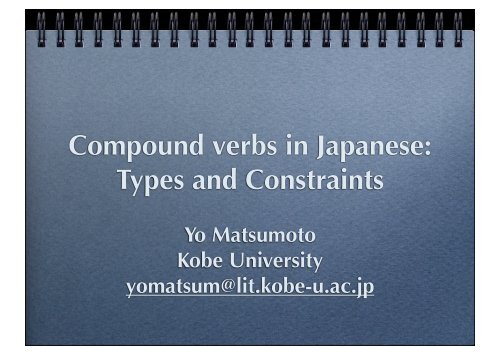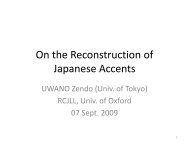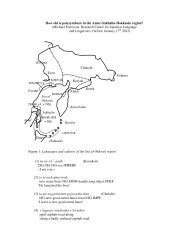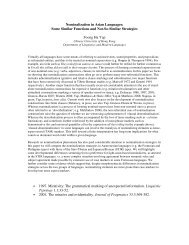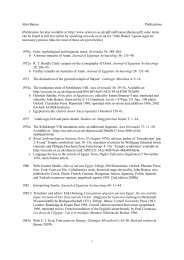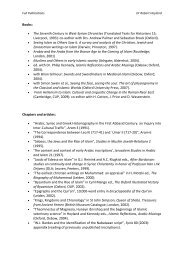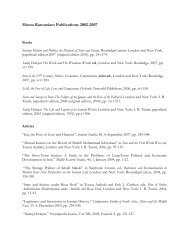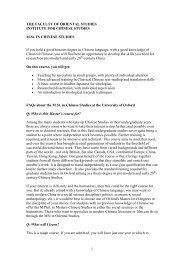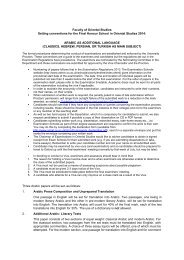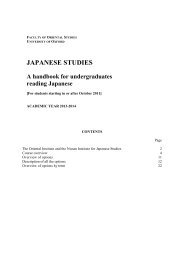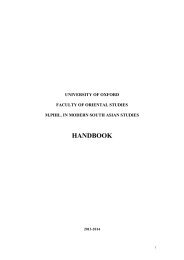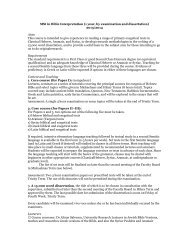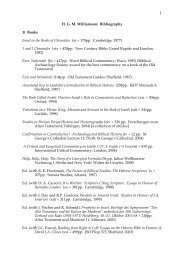Compound verbs in Japanese: Types and Constraints
Compound verbs in Japanese: Types and Constraints
Compound verbs in Japanese: Types and Constraints
You also want an ePaper? Increase the reach of your titles
YUMPU automatically turns print PDFs into web optimized ePapers that Google loves.
<strong>Compound</strong> <strong>verbs</strong> <strong>in</strong> <strong>Japanese</strong>:<br />
<strong>Types</strong> <strong>and</strong> Constra<strong>in</strong>ts<br />
Yo Matsumoto<br />
Kobe University<br />
yomatsum@lit.kobe-u.ac.jp
outl<strong>in</strong>e<br />
Basic properties of compound <strong>verbs</strong> <strong>in</strong> <strong>Japanese</strong><br />
Constra<strong>in</strong>ts on lexical compound <strong>verbs</strong><br />
previous solutions: general constra<strong>in</strong>ts<br />
proposal: constra<strong>in</strong>ts at multiple levels<br />
general <strong>and</strong> type-level constra<strong>in</strong>ts<br />
<strong>in</strong>dividual-level, knowledge-based constra<strong>in</strong>ts
Basic properties<br />
a sequence of two <strong>verbs</strong> as one word<br />
two major types: syntactic <strong>and</strong> lexical<br />
• syntactic: yomi-hazimeru (read-beg<strong>in</strong>)<br />
‘beg<strong>in</strong> to read’<br />
• lexical: osi-taosu (push-topple) ‘topple<br />
by push<strong>in</strong>g, push down’
Kare-wa hon-o yomi-hazime-ta<br />
He-Top book-Acc read-beg<strong>in</strong>-Pst<br />
‘He began to read a book.’<br />
Kare-wa hei-o osi-taosi-ta.<br />
He-Top fence-Acc push-topple-Pst<br />
‘He pushed down the fence.’
comparison with -te complexes<br />
V1s <strong>in</strong> compounds end <strong>in</strong> the Renyookei<br />
form; different from -te complexes<br />
compound:<br />
saka-o<br />
slope-Acc<br />
kake-agat-ta<br />
run-go.up-Pst<br />
-te complex<br />
saka-o<br />
slope-Acc<br />
kakete it-ta<br />
run-TE go-Pst
“lexical <strong>in</strong>tegrity”<br />
Unlike -te complexes, noth<strong>in</strong>g can be<br />
<strong>in</strong>serted between V1 <strong>and</strong> V2 <strong>in</strong> compounds<br />
saka-o kakete-wa it-ta ga...<br />
slope-Acc run-TE-Cont go-Pst but<br />
‘Though he ran (up) the slope, ...’<br />
*saka-o kake-wa agat-ta ga...<br />
slope-Acc run-Con go.up-Pst but<br />
‘Though he ran up the slope, ...’
lexical <strong>in</strong>tegrity of syntactic<br />
compounds<br />
V-te iru (progressive) vs V-hazimeru<br />
Kare-wa hon-o yonde-wa i-ta ga...<br />
he-Top book-Acc read-TE-Cont be-Pst but<br />
‘Though he was read<strong>in</strong>g a book, ...<br />
*Kare-wa hon-o yomi-wa hazime-ta ga...<br />
he-Top book-Acc read-Cont began but
syntactic <strong>and</strong> lexical compounds<br />
[Kare-wa [ ___ hon-o yomi]-hazime-ta]<br />
he-Top book-Acc read-beg<strong>in</strong>-Pst<br />
‘He began to read a book.’<br />
[Kare-wa hei-o osi-taosi-ta]<br />
he-Top fence-Acc push-topple-Pst<br />
‘He pushed the fence down.’
More on lexical compound <strong>verbs</strong><br />
1157 entries <strong>in</strong> Tagashira & Hoff;<br />
2936 <strong>in</strong> Iwanami Goitaikei;<br />
probably lots more (Who knows?)<br />
productive (<strong>in</strong> some types): new<br />
comb<strong>in</strong>ation is possible<br />
“fixed” comb<strong>in</strong>ations <strong>in</strong>volv<strong>in</strong>g archaic<br />
<strong>verbs</strong> are found
Major types<br />
Co-actions naki-sakebu (cry-shout) ‘cry out’<br />
Means osi-taosu (push-topple) ‘push down’<br />
Manner kake-agaru (run-go.up) ‘run up’<br />
Cause<br />
yake-s<strong>in</strong>u (be.burned-die) ‘die from<br />
be<strong>in</strong>g burned’<br />
Background tabe-nokosu (eat-leave.unconsumed)<br />
‘leave unconsumed <strong>in</strong> the act of eat<strong>in</strong>g’
Note: <strong>in</strong>choative/causative pairs<br />
koware(-ru)<br />
kowas(-u)<br />
taore(-ru)<br />
taos(-u)<br />
ak(-u)<br />
ake(-ru)<br />
‘be.destroyed, break(<strong>in</strong>tr.)’<br />
‘destroy, break (trans.)’<br />
‘fall over’<br />
‘topple’<br />
‘open (<strong>in</strong>transitive)’<br />
‘open (transitive)’
comparison with English<br />
Susan pushed the door {open/down}.<br />
<strong>Compound</strong>s lexically convey mean<strong>in</strong>gs<br />
which are conveyed through verb +<br />
particle/resultative constructions <strong>in</strong><br />
English<br />
<strong>Japanese</strong> osi-akeru/osi-taosu <strong>in</strong>volve<br />
transitive akeru ‘open’ <strong>and</strong> taosu ‘topple’<br />
as the head verb <strong>and</strong> <strong>in</strong> this respect<br />
different from English counterparts.
Comparison with Ch<strong>in</strong>ese<br />
Ta tui-dao-le dashu<br />
he push-fall.down Prf big.tree<br />
‘He pushed down a big tree.’<br />
Unlike Ch<strong>in</strong>ese, <strong>Japanese</strong> has transitive<br />
taosu ‘topple’ as V2; the subject of V1<br />
<strong>and</strong> V2 are shared <strong>in</strong> <strong>Japanese</strong>, but not <strong>in</strong><br />
Ch<strong>in</strong>ese.
Question<br />
Though productive, not all comb<strong>in</strong>ations are<br />
possible; 2,353 <strong>verbs</strong> would produce more<br />
than 5,500,000 comb<strong>in</strong>ations <strong>in</strong> theory.<br />
How are the comb<strong>in</strong>ations of lexical V-V<br />
compound <strong>verbs</strong> constra<strong>in</strong>ed?<br />
Subevents are <strong>in</strong>tegrated <strong>in</strong>to one (complex)<br />
event --> may suggest possible patterns <strong>in</strong><br />
which complex conceptual materials are<br />
<strong>in</strong>tegrated <strong>in</strong>to one whole <strong>in</strong> language.
Previous accounts:<br />
General solutions (only)<br />
transitivity match (traditional)<br />
“transitivity harmony” (Kageyama 1993)<br />
subject shar<strong>in</strong>g (Yumoto 1996, 2005,<br />
Matsumoto 1998)
Transitivity Match<br />
Transitive + Transitive<br />
tataki-kowasu (strike-destroy)<br />
Intransitive + Intransitive<br />
kake-agaru (run-go.up)<br />
*Transitive + Intransitive<br />
*tataki-kowareru (strike-be.destroyed)<br />
*Intransitive + Transitive<br />
*kake-ageru (run-make.go.up)
ut...<br />
Some transitive-<strong>in</strong>transitive comb<strong>in</strong>ations<br />
are found<br />
moti-aruku (have-walk) ‘carry around’
transitivity harmony<br />
Two types of <strong>in</strong>transitive <strong>verbs</strong><br />
• unaccusative (roughly, nonagentive changeof-state<br />
<strong>verbs</strong>)<br />
• unergative (roughly, agentive action <strong>verbs</strong>)<br />
New comb<strong>in</strong>atory generalizations (Kageyama 1993)<br />
OK: Transitive/unergative + Transitive/unergative<br />
OK: Unaccusative + Unaccusative<br />
bad: *Transitive/unegative + Unaccusative<br />
Issue of aruki-tsukareru (walk-get.tired) solved!
ut...<br />
Some unergative-unaccusative pairs are<br />
found <strong>in</strong> certa<strong>in</strong> semantic types<br />
(Matsumoto 1996)<br />
aruki-tukareru (walk-get.tired) ‘get tired<br />
from walk<strong>in</strong>g’
subject shar<strong>in</strong>g<br />
Subjects of V1 <strong>and</strong> V2 must be the same<br />
entity (Yumoto 1996, Matsumoto 1998)<br />
aruki-tukareru (walk-get.tired): subject<br />
shared<br />
*tataki-kowareru (strike-be.destroyed):<br />
subject unshared
V-V Nouns<br />
V-V nouns do not respect Subject-shar<strong>in</strong>g<br />
(Matsumoto 1998)<br />
V: omoi-dasu (th<strong>in</strong>k-make.go.out) ‘recall’<br />
N: omoi-de (th<strong>in</strong>k-go.out) ‘remembrance’
But...<br />
Subject-shar<strong>in</strong>g alone is too general <strong>and</strong><br />
says too little.<br />
tataki-kowareru (strike-be.destroyed)<br />
would be OK <strong>in</strong> the read<strong>in</strong>g where the<br />
striker is destroyed.<br />
Such compounds are ruled out because<br />
of queer semantics, but queerness must<br />
be separately accounted for.
General solutions II<br />
semantic constra<strong>in</strong>ts based on time <strong>and</strong><br />
causation (Matsumoto 1996: Ch. 10)<br />
Subevents of a complex event<br />
(represented by V1 <strong>and</strong> V2) must be<br />
temporally coextensive or causally<br />
related
But...<br />
Such constra<strong>in</strong>ts may be a necessary<br />
condition for a complex event to be<br />
expressed <strong>in</strong> a s<strong>in</strong>gle verb, they are too<br />
general to restrict possible lexical<br />
compounds.<br />
kake-agaru ‘run-go.up’<br />
*tati-yomu ‘st<strong>and</strong>-read’<br />
cf. tati-yomi suru (st<strong>and</strong>-read do)
The <strong>in</strong>adequacy of these general<br />
approaches was that they looked for<br />
general constra<strong>in</strong>ts without consider<strong>in</strong>g<br />
properties of different types of<br />
compounds
Solution<br />
While general constra<strong>in</strong>ts do exist,<br />
specific constra<strong>in</strong>ts on different types of<br />
lexical compounds must be recognized;<br />
some even at the level of <strong>in</strong>dividual<br />
items, too.<br />
--> Constra<strong>in</strong>ts are stated at multiple<br />
levels of generality (cf. Booij 2010,<br />
Goldberg 1995)
V1-V2<br />
general<br />
constra<strong>in</strong>ts<br />
V1cause-V2<br />
V1means-V2<br />
V1manner-V2<br />
type-level<br />
constra<strong>in</strong>ts<br />
tataki-kowasu<br />
osi-taosu<br />
<strong>in</strong>dividuallevel<br />
constra<strong>in</strong>ts
Type-level constra<strong>in</strong>ts<br />
Lexical compounds must be <strong>in</strong>terpreted <strong>in</strong><br />
a restricted set of semantic schemas. If they<br />
do not match any of such schemas, they are<br />
ruled out as “impossible compounds.”
major schemas<br />
Co-actions (Pair compounds <strong>in</strong> M96)<br />
Means<br />
Manner<br />
Cause<br />
Background (Not found <strong>in</strong> M96)
Note: represent<strong>in</strong>g verb semantics<br />
Bill broke the vase.<br />
[x CAUSES [Y BECOME Z]]<br />
CAUSATION<br />
CHANGE<br />
(STATE,<br />
LOCATION)
Co-action compound<strong>in</strong>g<br />
hikari-kagayaku (sh<strong>in</strong>e-sh<strong>in</strong>e.brightly) ‘sh<strong>in</strong>e brightly’<br />
naki-sakebu (cry-shout) ‘cry out’<br />
tobi-haneru (jump-leap) ‘jump up’<br />
V1 <strong>and</strong> V2 represent actions<br />
Actions of V1 <strong>and</strong> V2 must be the same action<br />
(described <strong>in</strong> different ways)<br />
V1 <strong>and</strong> V2 share their actors.
Co-action schema<br />
V1<br />
V2<br />
action<br />
identity
Means compound<strong>in</strong>g<br />
tataki-kowasu (strike-destroy) ‘destroy by strik<strong>in</strong>g’<br />
keri-ageru (kick-make.go.up) ‘kick up (<strong>in</strong> the air)’<br />
very productive<br />
V2 represents causation + change of state<br />
V1 represents action<br />
V1 is the means by which V2 is performed<br />
V1 <strong>and</strong> V2 share their subjects, <strong>and</strong> usually<br />
their objects
V1<br />
V2<br />
Means
Cause compound<strong>in</strong>g<br />
obore-s<strong>in</strong>u (be.drowned-die) ‘be drowned (to<br />
death)’<br />
aruki-tukareru (walk-get.tired) ‘get tired from<br />
walk<strong>in</strong>g’<br />
V2 must be nonagentive<br />
V1 can be agantive or nonagentive (<strong>in</strong><br />
violation of transitivity harmony)<br />
Undergoers/actors of V1 must be<br />
identical with the undergoer of V2
Cause schema<br />
V1<br />
V2<br />
process-type neutral
Manner compound<strong>in</strong>g<br />
kake-oriru (run-go.down) ‘run down’<br />
mai-agaru (dance-go.up) ‘soar up’<br />
V1 represents an action<br />
V2 represents motion (or similar activity)<br />
V1 represents the manner <strong>in</strong> which V2 is<br />
carried out.
Manner schema<br />
motion<br />
Manner<br />
action
nonexist<strong>in</strong>g schemas<br />
Non-subject-shar<strong>in</strong>g<br />
Nonsubject-shar<strong>in</strong>g cause-result schema<br />
Subject-shar<strong>in</strong>g<br />
• sequential actions<br />
• circumstantial situations
schema excluded <strong>in</strong> <strong>Japanese</strong><br />
V1<br />
V2<br />
cf. tui-dao (push-fall) <strong>in</strong> Ch<strong>in</strong>ese
*tataki-kowareru (strike-be.destroyed)<br />
*tataki-s<strong>in</strong>u (strike-die)<br />
There are restricted exceptions. They are not<br />
the direct results of compound<strong>in</strong>g but are<br />
derived from the means compounds.<br />
uti-agaru (hit-go.up) ‘go up due to shoot<strong>in</strong>g’<br />
< uti-ageru (hit-make.go.up) ‘shoot ... up’
Subj-shar<strong>in</strong>g cases excluded<br />
Circumstantial situations<br />
V-V nouns + suru permitted<br />
tati-guwi suru (st<strong>and</strong>-eat do) ‘eat while<br />
stad<strong>in</strong>g’<br />
tati-yomi suru (st<strong>and</strong>-read do) ‘read while<br />
st<strong>and</strong><strong>in</strong>g’<br />
V-V <strong>verbs</strong> are excluded<br />
*tati-kuwu (st<strong>and</strong>-eat), *tati-yomu (st<strong>and</strong>-read)
Subj-shar<strong>in</strong>g cases excluded<br />
sequential actions<br />
hiki-nige suru (hit-flee do) ‘hit <strong>and</strong> run’<br />
*hiki-nigeru (hit-flee)<br />
multiple (repeated) actions<br />
agari-sagari suru (go.up-go.down) ‘go up <strong>and</strong><br />
down repeatedly’,<br />
iki-ki suru (go-come do) ‘come <strong>and</strong> go<br />
repeatedly’<br />
*agari-sagaru, *iki-kuru
subject-shar<strong>in</strong>g<br />
as a general schema<br />
subject shar<strong>in</strong>g is a property of a “superschema,”<br />
i.e., a generalization of all<br />
major permitted compound<strong>in</strong>g schemas.<br />
Not all subject-shar<strong>in</strong>g schemas are<br />
permitted <strong>in</strong> compounds (hence we need<br />
a list of permitted ones), but all major<br />
schemas permitted <strong>in</strong>volve subjectshar<strong>in</strong>g<br />
(hence we need a generalization).
Subj-shar<strong>in</strong>g schema<br />
V2<br />
V1
constra<strong>in</strong>ts at the level of<br />
<strong>in</strong>dividual compounds<br />
semantic congruency<br />
Each compound must have a mean<strong>in</strong>g<br />
which is congruent with our general<br />
knowledge concern<strong>in</strong>g what typically or<br />
conventionally happen <strong>in</strong> the world.<br />
lexical economy<br />
Each lexical compound must have a reason<br />
for existence <strong>in</strong> light of lexical economy.
congruency<br />
Congruency <strong>in</strong>volves world knowledge<br />
(Fillmore’s “frame”)<br />
Each verb has a background <strong>in</strong>formation<br />
concern<strong>in</strong>g the likely causes <strong>and</strong> results<br />
of the process or the manners/means by<br />
which the process may be executed.
For example, a causative verb like break has<br />
a set of background <strong>in</strong>formation on how<br />
the change may be achieved; break<strong>in</strong>g can<br />
be achieved by actions <strong>in</strong>volv<strong>in</strong>g forceful<br />
contact (e.g., hitt<strong>in</strong>g) but not by<br />
nonforceful contact (e.g., lick<strong>in</strong>g).<br />
Each compound mean<strong>in</strong>g is checked aga<strong>in</strong>st<br />
such background knowledge. Incongruence<br />
results <strong>in</strong> <strong>in</strong>congruent compounds.
<strong>in</strong>congruent compounds<br />
• tataki-kowasu (strike-destroy) ‘strike to<br />
pieces’ vs. *name-kowasu (lick-destroy)<br />
• aruki-tukareru (walk-get.tired) vs. *arukis<strong>in</strong>u<br />
(walk-die)<br />
Our mental database says that one is likely<br />
to be tired after walk<strong>in</strong>g, but one does not<br />
usually die from it.
Change <strong>in</strong> our knowledge may lead to<br />
new compound<strong>in</strong>g possibilities.<br />
• name-otosu (lick-make.fall) ‘make ... fall<br />
off by lick<strong>in</strong>g’ may become acceptable<br />
after acquir<strong>in</strong>g the knowledge of horse<br />
mothers lick<strong>in</strong>g dirty objects off their<br />
foals’ sk<strong>in</strong>s.
lexical economy<br />
The pr<strong>in</strong>ciple of lexical economy rules out<br />
complex forms as unnecessary if they are<br />
synonymous with irregular/simpler forms<br />
(cf. *goed (=went), *pale red (≒p<strong>in</strong>k)).<br />
<strong>Compound</strong>s are blocked by (functionally)<br />
synonymous simple <strong>verbs</strong> or “more fixed”<br />
compound <strong>verbs</strong>.<br />
*kake-hairu (run-enter) cf. kake-komu<br />
*aruki-agaru (walk-go.up) cf. agaru
In conclusion<br />
<strong>Japanese</strong> lexical compounds do provide<br />
<strong>in</strong>terest<strong>in</strong>g data for the l<strong>in</strong>guistic<br />
patterns of packag<strong>in</strong>g complex mean<strong>in</strong>gs<br />
<strong>in</strong>to one whole.<br />
Constra<strong>in</strong>ts need to be stated at<br />
different levels of generality <strong>in</strong><br />
morphology.
Booij, Geert. 2010. Construction Morphology. Oxford: Oxford University<br />
Press.<br />
(Kageyama, Taro). 1993. <br />
Matsumoto,Yo. 1996. Complex Predicates <strong>in</strong> <strong>Japanese</strong>:A Syntactic <strong>and</strong><br />
Semantic Study of the Notion 'Word'. Stanford: CSLI Publications,<br />
Tokyo: Kurosio Publishers.<br />
(Matsumoto, Yo). 1998.<br />
114: 37~83<br />
Tagashira, Yoshiko, <strong>and</strong> Jean Hoff. 1986. H<strong>and</strong>book of <strong>Japanese</strong> <strong>Compound</strong><br />
Verbs. Tokyo: Hokuseido.<br />
(Yumoto, Yoko). 1996. <br />
105-118. <br />
(Yumoto, Yoko). 2005. ―


